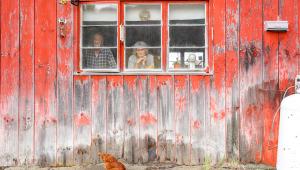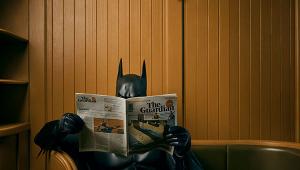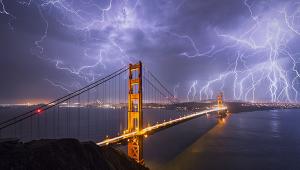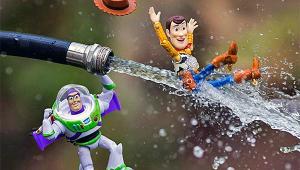Celebrity Portrait Photographer Patrick Ecclesine Has a Knack for Capturing Blockbuster Images
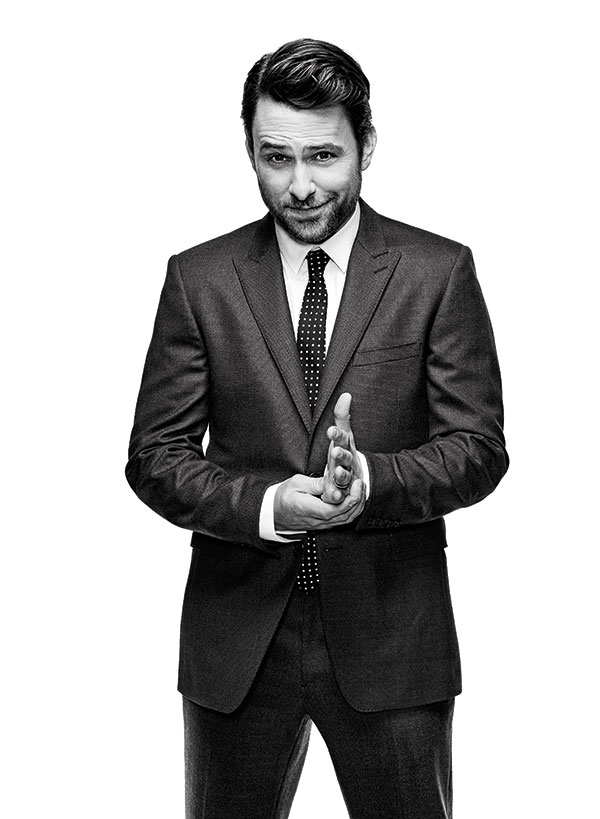
When Ecclesine shot this portrait of Charlie Day (“Horrible Bosses” and “It’s Always Sunny in Philadelphia”), he was impressed by the actor’s ability to take instructions. “Day is a natural comedic talent. I’d give him little directions. ‘Look up, look down. Take a few steps this way, take a few steps that way.’ He was easygoing and took direction. Together we were able to get a bunch of great shots. This is the one the magazine settled on.”
© Patrick Ecclesine
Just as the celebrities he photographs have to reinvent themselves for every role, Patrick Ecclesine is constantly putting on new hats as a photographer.
“As photographers, we have to remember what got us here today may not work tomorrow, in the sense that we constantly have to reinvent ourselves,” Ecclesine astutely affirms. “As a photographer, you’re there to capture a moment. Well, moments change, life changes, things evolve, and so you have to be open to that and not rest on your laurels or get stuck in your ways.”
This mantra has served Ecclesine well. He reinvented himself once to pursue his current path of celebrity photography. And he may reinvent himself yet again to meet changing trends and technologies. But let’s step back a moment to how he got his start.
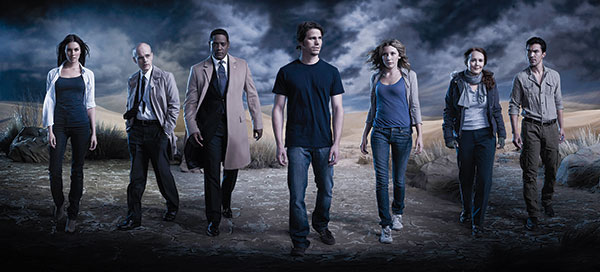
This was a complex production to promote the TV series “The Event.” Ecclesine photographed the entire set in one shot and then each actor individually, in the event (no pun intended) the studio wanted to use an alternate pose. “We built this massive desert set on a Universal Studios soundstage, with a custom-painted canvas backdrop.” The lighting involved 28 packs powering bi-tube heads, in a combination of Magnum reflectors for the backdrop and Elinchrom Deep Throats for the cast and foreground, plus a giant soft fill going through silks, from behind camera, and steel-blue-gelled hairlights for each actor. The shoot also involved wind and smoke machines.
Patrick Ecclesine/NBC
Humbling Beginnings
Ecclesine’s passion for photography began in high school and continued through his college years at UC Santa Barbara, where he studied theater and film. “In high school, I had gotten a lot of positive feedback, which led me to believe that I was an exceptional photographer,” he says. “However, when I stepped into the professional arena after college, I was humbled. I quickly realized, having never assisted, that I had a lot to learn.”
Ecclesine sought to soar with the stars. Except there was one roadblock en route to getting jobs shooting celebrities. “I went around to the different Hollywood studios, showing them my portfolio, and was told that I needed celebrities in my book.” The old catch-22: how and where to find a celeb to photograph when you haven’t yet proved yourself with celebs?
At this time, Ecclesine was waiting tables so he could afford to buy photo gear. He was fortunate that a famous actor, John Rhys-Davies (known for the Indiana Jones and Lord of the Rings films), patronized the restaurant. Rhys-Davies agreed to do a photo shoot, even though it would take place not in a fancy studio but in Ecclesine’s garage.
That still did not exactly get him the break he needed. Ecclesine’s first professional photography job came in 2001 when he got involved in shooting an extreme team sport called SlamBall for a national TV syndicate, which led to his role as league photographer. “As the sport became more widely televised, I went along with it, which paved my way into union membership with the Cinematographers Guild,” he recalls. “Once I became a full-fledged union member, I was able to work on sets and shoot for the studios. I worked behind the scenes as a unit (still) photographer on many major TV shows for about three years. It was like reportage, without subjecting yourself to hazardous situations, except that on any particular day, you might evoke the ire of an actor who’s having a bad day and decides to eye you as a paparazzo.”

“Preferably we’d get everything in one shot. But we couldn’t do that for this shoot promoting ‘Homeland,’ since both Claire Danes and Damian Lewis were in different cities at the time. And there was no time to wait. I had to shoot this right before the show aired, at each of their respective locations.” The lighting is exactly the same for both of them, so that a credible composite could be created. “I also shot static noise on an old CRT TV, which Showtime’s creative team incorporated to help create the digital feel for the image.”
© Patrick Ecclesine
Faces Of Sunset Boulevard
It may have been a steady job, albeit part-time, but Ecclesine soon tired of the mechanical and contrived nature of the work. “I never wanted to be a unit photographer. I wanted to create beautiful, telling portraits. The problem was, in L.A. the real jobs in the entertainment industry revolved around celebrity portraits. But no one would hire you unless you had a book full of celebrities, and at that point I had only one. I knew I needed to do something that would force me to evolve.”
The next step was a huge one. Ecclesine decided to sink “every dime I made as a still photographer for four years and put it into producing a book called Faces of Sunset Boulevard: A Portrait of Los Angeles. This was a photographic time capsule of what it was like to live in L.A. in a four-year period, beginning in 2004. I did these huge productions involving street closures, the L.A. fire department, the mayor, police chief, crackheads, celebrities, maids, housewives, and all walks of life, encompassing hundreds of interviews and photographs along the ‘boulevard of dreams.’”
The book garnered high praise and doors were opened. “That really got my career going,” he says.

For this portrait of James Spader, star of “The Blacklist,” Ecclesine decided a hard light would be most appropriate, which he achieved with gridded beauty dishes, “in keeping with the noir tenor of the show. This hard-edged lighting conveys drama and scope and power, which perfectly suits the actor and the character he portrays.” The backdrop is a dove gray seamless lit with umbrellas that were pointed downward to create a natural gradation.
Patrick Ecclesine/NBC
A Pressure Cooker
“In the work I do, there’s a difference between being a good photographer and being able to deal with very high-pressure situations. Clients expect you to deliver every time, in the least amount of time. There’s a tremendous amount of coordination and dealing with publicists who have talent concerns, design teams who have layout concerns, the studio which has their own set of concerns, all the while sorting out set construction, wardrobe, hair and makeup, caterers, assistants, and production crews.”
Are most celebs easy to work with? I ask Ecclesine. “The best way to answer that is to say, celebrities are under inordinate amounts of pressure, much more so than ordinary people,” he replies. “So much is expected of them, demanded of them, asked of them. It’s a very challenging profession to have your anonymity gone. Some of them are very comfortable with that fact. They love it. Others face fame reluctantly and are wary of the camera. As a result, you have to read people very quickly and get through to them.”

For his book “Faces of Sunset Boulevard,” Ecclesine captured a diversity of personalities who could be found on this famous thoroughfare, among them William J. Bratton, who was then LAPD Chief of Police. “It was 5:30 p.m. in the summer. The sun was setting over the city. We were on the LAPD’s helipad. Everything was planned, right down to the helicopter flying in front of the sun, so that it cast a shadow over the scene. Before the shoot started I told Chief Bratton that I was going to take the best portrait of his life. He looked at me like I was from outer space. He gave me five minutes and the shoot was over.” Ecclesine lit the officers with three Magnum reflectors powered by three Profoto 7b’s—one for the chief, one for the deputies, and one as a rimlight at camera right. Bratton loved the shot.
© Patrick Ecclesine
Taking Charge
Part of that also involves knowing how to give direction. Actors are talented individuals, but directors exist for a purpose, to get at the core of these talents. “The goal is to get them relaxed, because if they’re not relaxed, you don’t have a good shot. That’s number one.”
Ecclesine explains further: “Getting them to relax has to do with being professional. I tell them to breathe and get centered, and make sure you feel your feet. A lot of the magic happens on the exhale. When the person exhales, then all of a sudden that’s when they’re most relaxed. That’s the one moment of truth that you’ve got, that they give you. That’s when the magic happens.
“A lot of people do little physical things: look to the left, look to the right, look at me, walk back and forth to a mark. Anything to keep them loose and out of their heads. Because when you’re in your head, you’re dead. So they’ve got to be experiencing an interaction with your camera, instead of sitting there with their jaw clenched, trying to figure out what to do next.”

Ecclesine shot this portrait of fashion model Donna Feldman using an Elinchrom Deep Throat positioned at camera right, aimed downward at a steep angle. Behind that he had a soft fill consisting of a Photek umbrella through a 6x6-foot silk. The backdrop is painted canvas lit by a single umbrella from above.
© Patrick Ecclesine
Patrick Ecclesine’s Gear Choices
Ecclesine owns a Canon EOS 5D Mark III, which he largely uses for editorial and personal work. On studio shoots he uses Industrial Color, which provides Hasselblads with digital backs, along with a computer workstation and digital tech. Whereas the studios do the retouching and compositing on jobs where they have total control over the images, Ecclesine’s team tackles those tasks themselves for editorial and personal work, in Capture One and Photoshop.
Ecclesine’s lighting gear of choice is Profoto, to which he adds various lightshapers. He prefers Photek 46-inch umbrellas with a sock over them for location work (“They’re really good for running and gunning in the field, and usually with Profoto 7b’s”). Another favorite is the Elinchrom Rotalux Deep Throat Octa Softbox (“The light is very soft but focused; I use it for moody portraits”). He also uses beauty dishes with a grid.
Celebrity portrait photographer Patrick Ecclesine is based in Hollywood, CA. To view more of his work, visit www.ecclesine.com. Ecclesine is also a partner in a commercial aerial cinematography company which employs a fleet of drones, camera systems, and operators (www.wildrabbitproductions.com).




